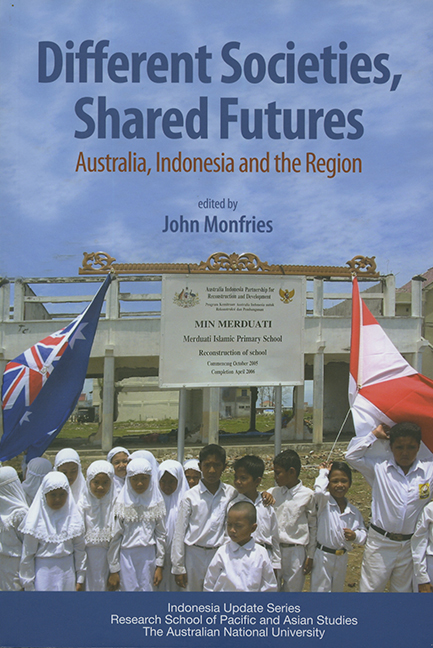Book contents
- Frontmatter
- Dedication
- Contents
- Tables
- Figures
- Contributors
- Acknowledgments
- Opening Address by Richard Woolcott AC
- 1 Introduction
- PART I Regional Viewpoints
- PART II Security Aspects
- PART III Mutual Perceptions and Irritations
- PART IV The Economic Partnership: Aid, Economics and Business
- 10 The Australia–Indonesia Partnership for Reconstruction and Development
- 11 The SBY Promise to the Business World
- 12 Australia and Indonesia in the Wider Context of Regional Economic Relations
- PART V Conclusion
- Glossary
- References
- Index
10 - The Australia–Indonesia Partnership for Reconstruction and Development
from PART IV - The Economic Partnership: Aid, Economics and Business
Published online by Cambridge University Press: 21 October 2015
- Frontmatter
- Dedication
- Contents
- Tables
- Figures
- Contributors
- Acknowledgments
- Opening Address by Richard Woolcott AC
- 1 Introduction
- PART I Regional Viewpoints
- PART II Security Aspects
- PART III Mutual Perceptions and Irritations
- PART IV The Economic Partnership: Aid, Economics and Business
- 10 The Australia–Indonesia Partnership for Reconstruction and Development
- 11 The SBY Promise to the Business World
- 12 Australia and Indonesia in the Wider Context of Regional Economic Relations
- PART V Conclusion
- Glossary
- References
- Index
Summary
The massive earthquakes and tsunami that hit countries on the Indian Ocean rim on 26 December 2004 produced a natural disaster on a scale seldom seen. In Indonesia alone, three-quarters of a million people were direct victims: more than 150,000 people died or are still missing, over 500,000 people lost their homes and 150,000 children lost their schools (World Bank 2005b). The Australian government's response was quick and comprehensive, with the immediate commitment of seven emergency medical teams, major Australian Defence Force assets, civilian disaster experts, and $60 million in humanitarian assistance funding and material support for the emergency relief effort across the region.
Within a few days it was clear from the initial damage reports that Indonesia should be the focus of Australia's relief and reconstruction efforts. It was also clear that the task of reconstruction would be enormous, and would add significantly to the challenges facing the new administration of President Susilo Bambang Yudhoyono in restoring international confidence in Indonesia's economy and improving the quality of life of more than 220 million Indonesians.
This thinking underpinned the design of the Australia–Indonesia Partnership for Reconstruction and Development (AIPRD). From initial discussions of the concept among Australian officials to its public announcement by Australian Prime Minister John Howard and Indonesian President Yudhoyono on 5 January 2005 the entire process took less than a week, a remarkably fast timeframe for a $1 billion package that constituted Australia's largest ever foreign aid commitment.
The Australian prime minister referred to the new partnership as ‘an historic step’ in the relations between Australia and Indonesia and ‘a strategic commitment’ to raise living standards in Indonesia. He noted that this would be ‘significantly different in scale and approach from any previous aid effort’ and that it would ‘serve to bring our countries and peoples closer together’ (Howard 2005a, 2005b). He also emphasised a number of other characteristics of the package, in particular that it was a bilateral undertaking to be implemented jointly, that the funding would be additional to Australia's existing aid commitments to Indonesia and that, while there would be a clear focus on tsunami-affected areas, all areas of Indonesia would be eligible for assistance under the partnership.
- Type
- Chapter
- Information
- Different Societies, Shared FuturesAustralia, Indonesia and the Region, pp. 129 - 142Publisher: ISEAS–Yusof Ishak InstitutePrint publication year: 2006

